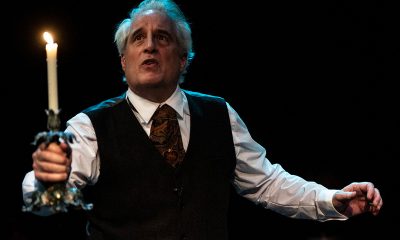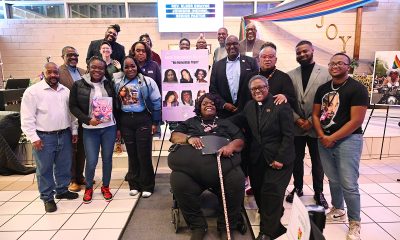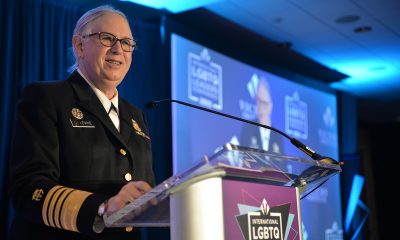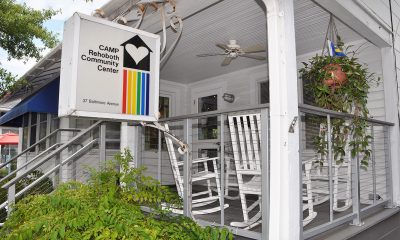Commentary
Reflecting on Center Faith’s Pride interfaith service
Much work to be done before welcoming the world in 2025

“We must not rest! We must not rest! We must not rest!” These words rang out in Foundry Methodist Church during Center Faith’s recent 2024 Pride Interfaith Service. Rev. Cathy Alexander, associate pastor at the Metropolitan Community Church (MCC)-Washington, DC, implored everyone in attendance to keep fighting “until the doors of churches and temples and houses of faith open wide in welcome to all people.” She quoted Reverend Troy Perry, founder of the first MCC church in 1968, from the 2000 Millennium March for Equality.
It was a moving reminder of the many LGBTQ elders who have passed on, who have fought for LGBTQ rights today and made this service, held in a rainbow draped church, possible. This was especially meaningful as this year’s service also remembered Allan Armas — co-founder of the Pride Interfaith Service — who died this past October.
Held on a drizzly evening, the service began with an opening drum call to gather by members of the Unity Fellowship Church of Washington, D.C., and a procession of all presenters. Church Elder and Unity Fellowship Pastor Akosua McCray offered a libation to the ancestors, like Armas, who won many of the rights that LGBTQ individuals have today. “Let us together call out their names and invite their spirit here today,” McCray shared. “Carlton Smith,” an attendee shouted from the back. “Allan Armus,” said another. “Marsha P. Johnson.” “Bishop Thomas Gumbleton.” With each name, McCray filled a red vase with water in their honor.
Thus commenced the 41st annual Pride Interfaith Service, focused on the radical past, present, and future of LGBTQ interfaith action in the nation’s capital. The three-part service resonated with Capital Pride’s theme of “Totally Radical!” and included representatives from the DC LGBTQ+ Community Center and Mayor’s Office of LGBTQ Affairs. McCray’s Libation was the first part of the creation and blessing of a sacred space, featuring a call to the elements, directions and divine by Jonathan White of Stone Circle Wicca, a call to prayer by Nabeel Kirmani and translated by Sister Michelle Munson of Muslims for Progressive Values, and an opening prayer by Rev. Thomas Wieczorek from the National Catholic Church, among others.
GenOut Chorus, the youth chorus for the Gay Men’s Chorus of Washington, D.C., provided music, opening with Philip Silvey’s “Always a Place for You.” Their song began a reflection on the radical origins of the Pride Interfaith Service all the way back to the 1960s. Reverend Elder Robert “Michael” Vanzant, a Doctor of Theology at the Faith Temple and one of the pioneers of the Pride Interfaith Service, recounted his own journey from a fundamentalist rural Southern community all the way to the steps of the Temple Church of God in Christ on Sunday, Sept. 19, 1982.
Together, he and 16 others “embraced being same-gender loving and created a gathering of predominantly people of color, called a Third World gathering, to create a community for our sacred selves.” They gathered with signs, his reading “My house shall be called a house of prayer for all people” (Isaiah 56:&, Mark 11:17), after a Church elder Dr. James Tenney was told by the Bishop that by including LGBTQ+ individuals at All Souls Church DC, he had excommunicated himself from the Church. The bishop warned that Tenney’s problem was that he had no shame so the group gathered that Sunday morning before and after church “bearing witchess that we lived our lives without shame.” Thus Faith Temple was born.
Rev. Cathy Alexander reflected on MCC’s own history, followed by Rev. Eric Eldrith, Pagan clergy with Circle Sanctuary, Kirmani, Jonathan White, myself, and Armas’s best friend cellist John Kaboff sharing fond memories and words of love and life about Armas. Eldritch spoke to Armas’s radical welcome of him as an ex-ex-gay fundamentalist to a Radical Faerie to Pagan clergy at Circle Sanctuary. This tribute spoke to the importance of all including faith communities beyond Abrahamic traditions. Pagan, Wiccan, and folk magic communities have for centuries been places of belonging and acceptance for LGBTQ+ people but are normally excluded from LGBTQ+ religious historical narratives. Armas challenged this exclusion.
“His deeply held Jewish faith,” White explained, “led him to care passionately about justice and liberation for all people, especially LGBTQ+ people, and to pursue justice as part of his own spiritual journey. He was humane, kind, thoughtful–he was a mensch. May his memory be a blessing.” He led his community surrounded by elders until he himself became one; one of the far too few LGBTQ+ elders who see the realization of their efforts. White celebrated this queer elderhood in Armas’s faith community, of bringing his experiences and wisdom to the community he helped to create. Kaboff played a Jewish funeral piece–one performed at an annual memorial service Armas founded, and Rabbi Jake Beilin-Singer blew the shofar, an instrument sounded during High Holy Day services, in recognition of his leadership.
Armas’s radical welcome has made LGBTQ faith experiences possible, from radical living as interfaith families, to radical justice through collective liberation, to radical presents through living as authentic selves, and radical leadership through DC’s LGBTQ+ religious leaders including the first lesbian rabbi, Julie Spitzer, at the Baltimore Hebrew Congregation in 1987. Even radical pride from that first Pride Interfaith Service in 1983.
During this time when over 500 anti-LGBTQ bills have been introduced in state legislatures across the country, lay member of Sunstone Chapel Ebony C. Peace called us to remember, “hatred continues to come our way in full force because our liberation threatens their control. The liberation of all people threatens them. They are coming at us strong because we ourselves have become stronger.” It is only through love, Peace shared, that we can drive out hatred. This was especially true when two protestors interrupted the service, and were met with all attendees singing “This Little Light of Mine” to drown out their voices as ushers escorted them outside.
The service ended by envisioning this future of love, including radical inclusive love in faith communities and interfaith relationships that imagine a future of collaboration with newly established groups like Queerly Gathered, introduced by Presbyterian minister Matt Nabinger and Cali Bronkema.
Richmond looked ahead toward World Pride to be held in D.C. in 2025. Just as attendees committed this year’s service to “demonstrating the breath, depth, and sincerity of our faith, exposing the lie that anti-gay fundamentalists have a monopoly on faith and religion,” Pride Interfaith Service planner Jonah Richmond shared, next year’s service will include people from around the world remembering their LGBTQ religious histories, celebrating their presents, and pushing for LGBTQ+ religious liberation and community. It will celebrate LGBTQ elders of faith from around the world. As Alexander said, we must not rest! There is much work to be done before welcoming the world at the next service on June 3, 2025.
Emma Cieslik served as a historian for this year’s Pride Interfaith Service.
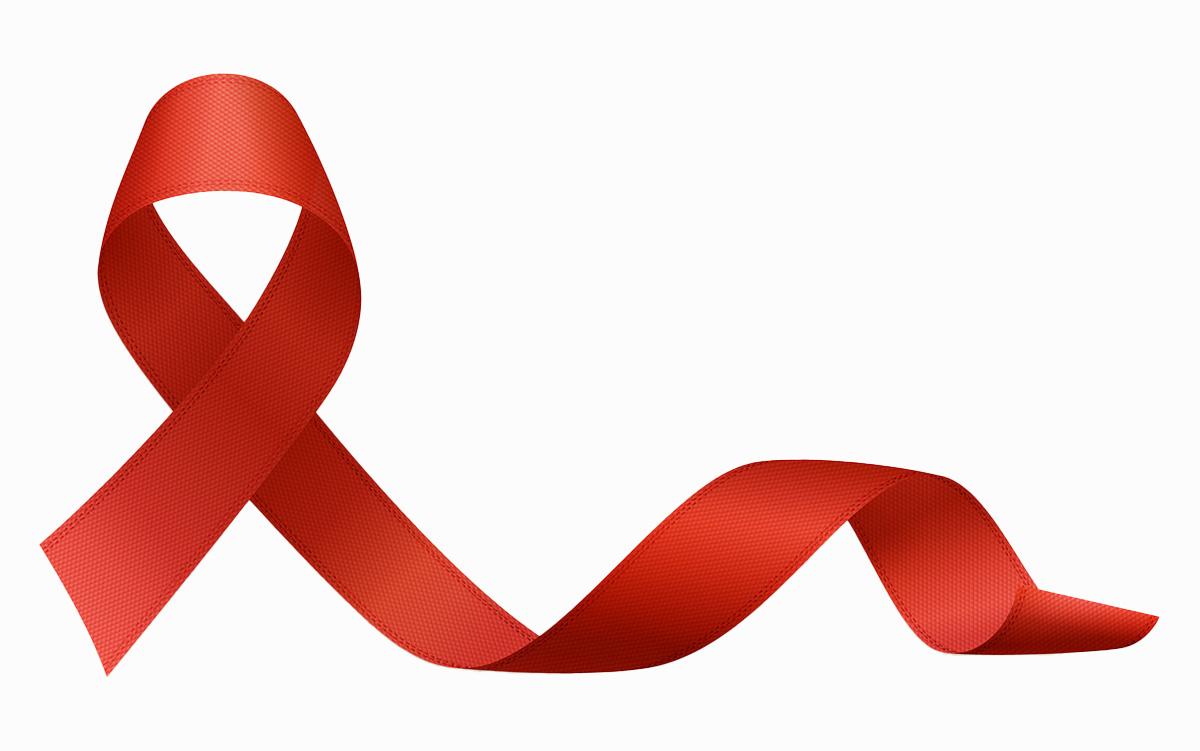
Today, on World AIDS Day, we honor the resilience, courage, and dignity of people living with HIV everywhere especially refugees, asylum seekers, and queer displaced communities across East Africa and the world.
For many, living with HIV is not just a health journey it is a journey of navigating stigma, borders, laws, discrimination, and survival.
Yet even in the face of displacement, uncertainty, and exclusion, queer people living with HIV continue to rise, thrive, advocate, and build community against all odds.
To every displaced person living with HIV:
• Your strength inspires us.
• Your story matters.
• You are worthy of safety, compassion, and the full right to health.
• You deserve a world where borders do not determine access to treatment, where identity does not determine dignity, and where your existence is celebrated not criminalized.
Let today be a reminder that:
• HIV is not a crime.
• Queer identity is not a crime.
• Seeking safety is not a crime.
• Stigma has no place in our communities.
• Access to treatment, care, and protection is a human right.
As we reflect, we must recommit ourselves to building systems that protect not punish displaced queer people living with HIV. We must amplify their voices, invest in inclusive healthcare, and fight the inequalities that fuel vulnerability.
Hope is stronger when we build it together.
Let’s continue to uplift, empower, and walk alongside those whose journeys are too often unheard.
Today we remember.
Today we stand together.
Today we renew hope.
Abraham Junior lives in the Gorom Refugee Settlement in South Sudan.
Commentary
Perfection is a lie and vulnerability is the new strength
Rebuilding life and business after profound struggles
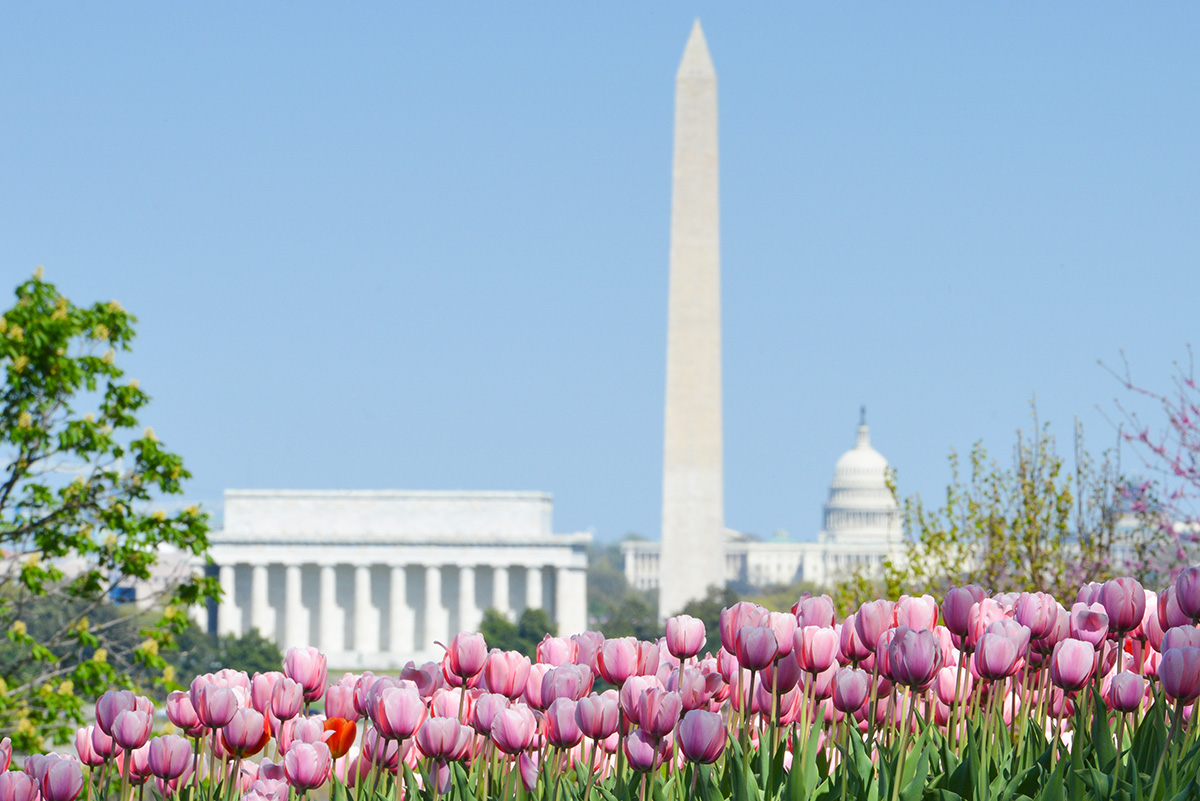
I grew up an overweight, gay Black boy in West Baltimore, so I know what it feels like not to fit into a world that was not really made for you. When I was 18, my mother passed from congestive heart failure, and fitness became a sanctuary for my mental health rather than just a place to build my body. That is the line I open most speeches with when people ask who I am and why I started SWEAT DC.
The truth is that little boy never really left me.
Even now, at 42 years old, standing 6 feet 3 inches and 225 pounds as a fitness business owner, I still carry the fears, judgments, and insecurities of that broken kid. Many of us do. We grow into new seasons of life, but the messages we absorbed when we were young linger and shape the stories we tell ourselves. My lack of confidence growing up pushed me to chase perfection as I aged. So, of course, I ended up in Washington, D.C., which I lovingly call the most perfection obsessed city in the world.
Chances are that if you are reading this, you feel some of that too.
D.C. is a place where your resume walks through the door before you do, where degrees, salaries, and the perfect body feel like unspoken expectations. In the age of social media, the pressure is even louder. We are all scrolling through each other’s highlight reels, comparing our behind the scenes to someone else’s curated moment. And I am not above it. I have posted the perfect photo with the inspirational “God did it again” caption when I am feeling great and then gone completely quiet when life feels heavy. I am guilty of loving being the strong friend while hating to admit that sometimes I am the friend who needs support.
We are all caught in a system that teaches us perfection or nothing at all. But what I know for sure now is this: Perfection is a lie and vulnerability is the new strength.
When I first stepped into leadership, trying to be the perfect CEO, I found Brené Brown’s book, “Daring Greatly” and immediately grabbed onto the idea that vulnerability is strength. I wanted to create a community at SWEAT where people felt safe enough to be real. Staff, members, partners, everyone. “Welcome Home” became our motto for a reason. Our mission is to create a world where everyone feels confident in their skin.
But in my effort to build that world for others, I forgot to build it for myself.
Since launching SWEAT as a pop up fundraiser in 2015, opening our first brick and mortar in 2017, surviving COVID, reemerging and scaling, and now preparing to open our fifth location in Shaw in February 2026, life has been full. Along the way, I went from having a tight trainer six pack to gaining nearly 50 pounds as a stressed out entrepreneur. I lost my father. I underwent hip replacement surgery. I left a relationship that looked fine on paper but was not right. I took on extra jobs to keep the business alive. I battled alcoholism. I faced depression and loneliness. There are more stories than I can fit in one piece.
But the hardest battle was the one in my head. I judged myself for not having the body I once had. I asked myself how I could lead a fitness company if I was not in perfect shape. I asked myself how I could be a gay man in this city and not look the way I used to.
Then came the healing.
A fraternity brother said to me on the phone, “G, you have to forgive yourself.” It stopped me in my tracks. I had never considered forgiving myself. I only knew how to push harder, chase more, and hide the cracks. When we hung up, I cried. That moment opened something in me. I realized I had not neglected my body. I had held my life and my business together the best way I knew how through unimaginable seasons.
I stopped shaming myself for not looking like my past. I started honoring the new ways I had proven I was strong.
So here is what I want to offer anyone who is in that dark space now. Give yourself the same grace you give everyone else. Love yourself through every phase, not just the shiny ones. Recognize growth even when growth simply means you are still here.
When I created SWEAT, I hoped to build a home where people felt worthy just as they are, mostly because I needed that home too. My mission now is to carry that message beyond our walls and into the city I love. To build a STRONGER DC.
Because strength is not perfection. Strength is learning to love an imperfect you.
With love and gratitude, Coach G.
Gerard Burley, also known as Coach G, is a D.C.-based fitness entrepreneur.
Commentary
Elusive safety: what new global data reveals about gender, violence, and erasure
Movements against gender equality, lack of human rights data contributing factors.
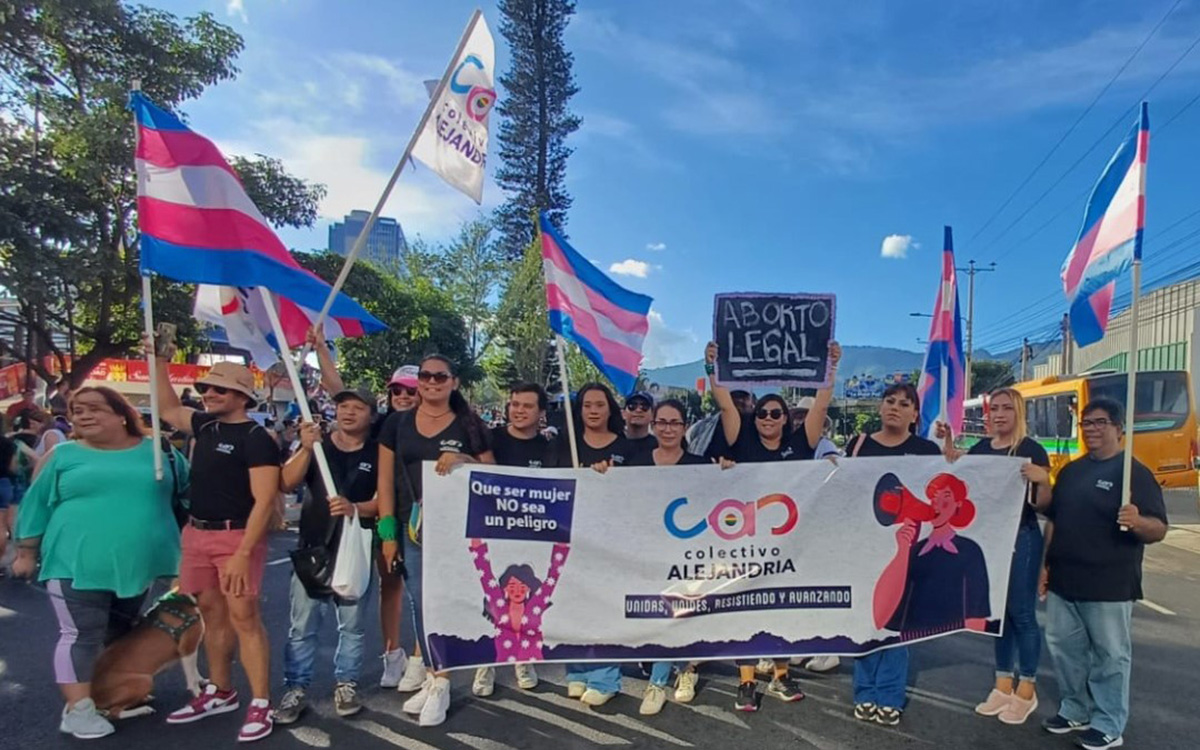
“My identity could be revealed, people can say whatever they want [online] without consequences. [Hormone replacement therapy] is illegal here so I’m just waiting to find a way to get out of here.”
-Anonymous respondent to the 2024 F&M Global Barometers LGBTQI+ Perception Index from Iraq, self-identified as a transgender woman and lesbian
As the campaign for 16 Days Against Gender-Based Violence begins, it is a reminder that gender-based violence (GBV) — both on– and offline — not only impacts women and girls but everyone who has been harmed or abused because of their gender or perceived gender. New research from the Franklin & Marshall (F&M) Global Barometers and its report A Growing Backlash: Quantifying the Experiences of LGBTQI+ People, 2022-2024 starkly show trends of declining safety among LGBTQI+ persons around the world.
This erosion of safety is accelerated by movements against gender equality and the disappearance of credible human rights data and reporting. The fight against GBV means understanding all people’s lived realities, including those of LGBTQI+ people, alongside the rights we continue to fight for.
We partnered together while at USAID and Franklin & Marshall College to expand the research and evidence base to better understand GBV against LGBTQI+ persons through the F&M Global Barometers. The collection of barometers tracks the legal rights and lived experiences of LGBTQI+ persons from 204 countries and territories from 2011 to the present. With more than a decade of data, it allows us to see how rights have progressed and receded as well as the gaps between legal protections and lived experiences of discrimination and violence.
This year’s data reveals alarming trends that highlight how fear and violence are, at its root, gendered phenomena that affect anyone who transgresses traditional gender norms.
LGBTQI+ people feel less safe
Nearly two-thirds of countries experienced a decline in their score on the F&M Global Barometers LGBTQI+ Perception Index (GBPI) from 2022-2024. This represents a five percent drop in global safety scores in just two years. With almost 70 percent of countries receiving an “F” grade on the GBPI, this suggests a global crisis in actual human rights protections for LGBTQI+ people.
Backsliding on LGBTQI+ human rights is happening everywhere, even in politically stable, established democracies with human rights protections for LGBTQI+ people. Countries in Western Europe and the Americas experienced the greatest negative GBPI score changes globally, 74 and 67 percent, respectively. Transgender people globally reported the highest likelihood of violence, while trans women and intersex people reported the highest levels of feeling very unsafe or unsafe simply because of who they are.
Taboo of gender equality
Before this current administration dismantled USAID, I helped create an LGBTQI+ inclusive whole-of-government strategy to prevent and respond to GBV that highlighted the unique forms of GBV against LGBTQI+ persons. This included so-called ‘corrective’ rape related to actual or perceived sexual orientation, gender identity, or expression” and so-called ‘conversion’ therapy practices that seek to change or suppress a person’s gender identity or expression, sexual orientation, or sex characteristics. These efforts helped connect the dots in understanding that LGBTQI+ violence is rooted in the same systems of inequality and power imbalances as the broader spectrum of GBV against women and girls.
Losing data and accountability
Data that helps better understand GBV against LGBTQI+ persons is also disappearing. Again, the dismantling of USAID meant a treasure trove of research and reports on LGBTQI+ rights have been lost. Earlier this year, the US Department of State removed LGBTQI+ reporting from its annual Human Rights Reports. These played a critical role in providing credible sources for civil society, researchers, and policymakers to track abuses and advocate for change.
If violence isn’t documented, it’s easier for governments to deny it even exists and harder for us to hold governments accountable. Yet when systems of accountability work, governments and civil society can utilize data in international forums like the UN Universal Periodic Review, the Convention on the Elimination of All Forms of Discrimination Against Women, and the Sustainable Development Goals to assess progress and compliance and call for governments to improve protections.
All may not be lost if other countries and donors fill the void by supporting independent data collection and reporting efforts like the F&M Global Barometers and other academic and civil society monitoring. Such efforts are essential to the fight against GBV: The data helps show that the path toward safety, equality, and justice is within our reach if we’re unafraid of truth and visibility of those most marginalized and impacted.
Jay Gilliam (he/him/his) was the Senior LGBTQI+ Coordinator at USAID and is a member of the Global Outreach Advisory Council of the F&M Global Barometers.
Susan Dicklitch-Nelson (she/her/hers) is the founder of the F&M Global Barometers and Professor of Government at Franklin & Marshall College.
-

 Congress4 days ago
Congress4 days agoEXCLUSIVE: George Santos speaks out on prison, Trump pardon, and more
-

 The White House4 days ago
The White House4 days agoWhite House deadnames highest-ranking transgender official
-

 The White House4 days ago
The White House4 days agoAs house Democrats release Epstein photos, Garcia continues to demand DOJ transparency
-

 Opinions4 days ago
Opinions4 days agoReflecting on six years on the CAMP Rehoboth board



